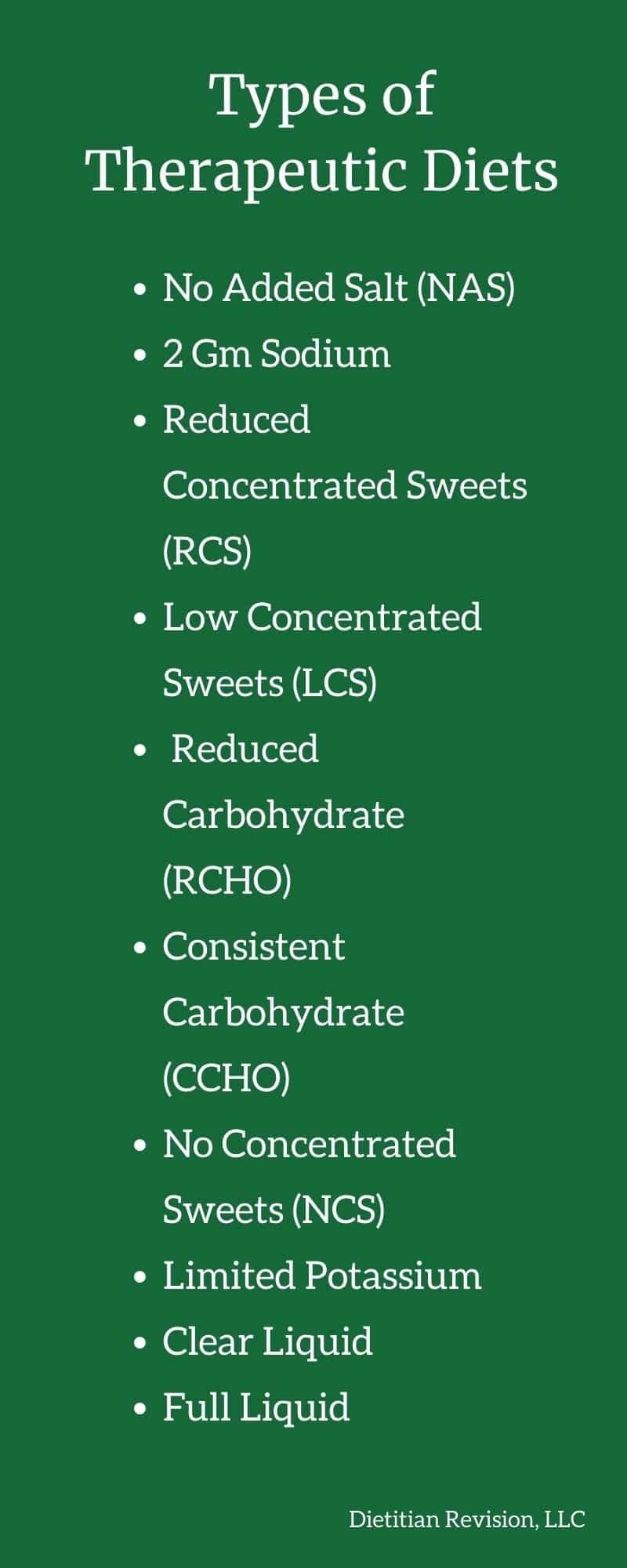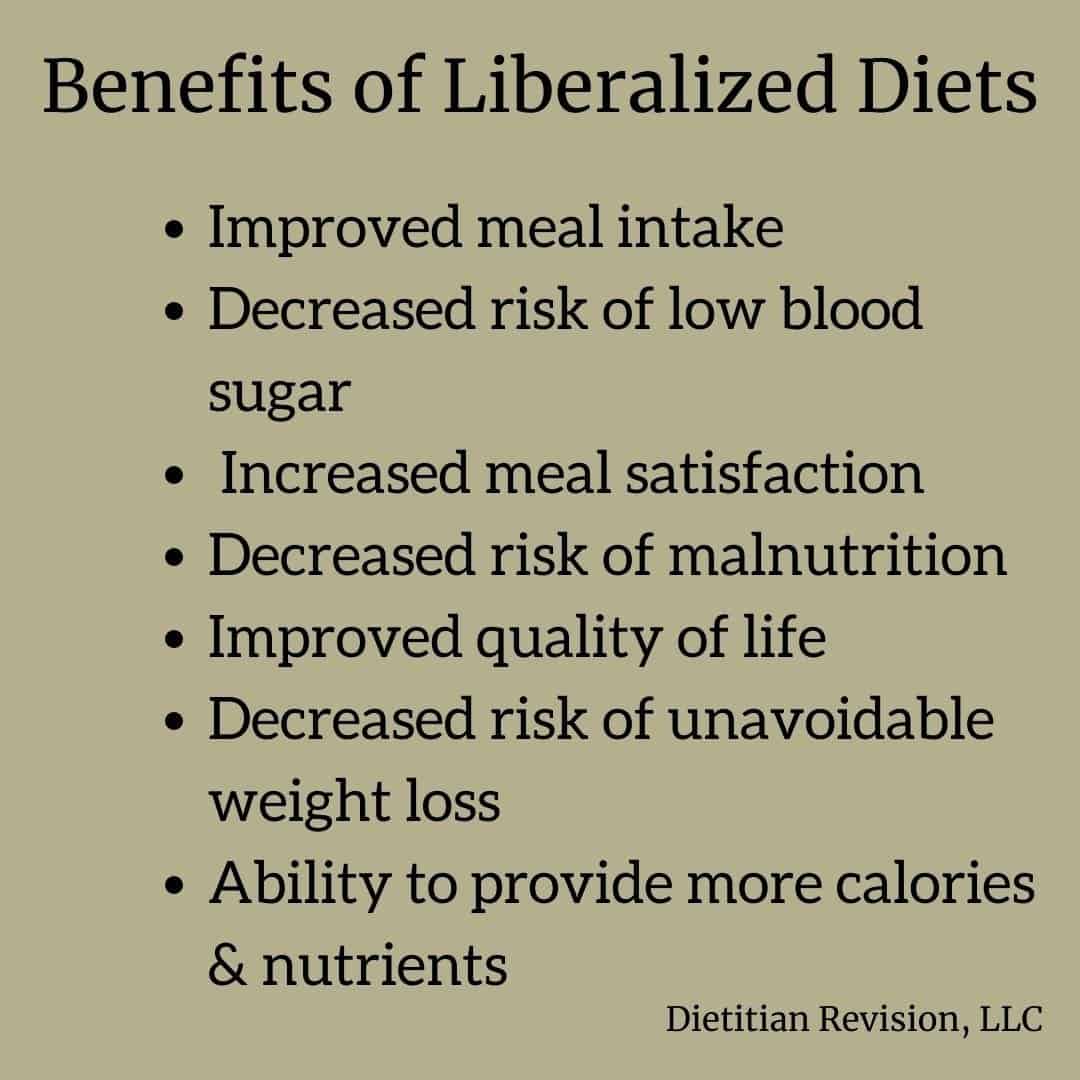Therapeutic diets used in long term care (LTC) are less restrictive than many traditionally thought of “diets.” This is due to the increased risk of inadequate intake and malnutrition of the geriatric population.
This article will explain the common therapeutic diets used in long term care facilities and rationale for more liberalized diets for the elderly.
What is a Therapeutic Diet?
A therapeutic diet is a meal plan where foods and/or nutrients are adjusted to assist with controlling medical conditions or symptoms. Nutrients may be eliminated, decreased, or increased in order to manage disease states.
Dietitians, in collaboration with the interdisciplinary team, assess nutritional status of long term care residents to determine appropriate diet.
Diets may be adjusted throughout disease progression, as they may become less appropriate as unavoidable declines occur.
Types of Therapeutic Diets
For Sodium
Limited sodium may be appropriate for those with hypertension, heart failure, and kidney disease.
NAS Diet
No Added Salt diet (NAS diet) is the most common diet used when a sodium restriction is desired. This is a regular diet without sending additional salt at meals.
2 Gram Sodium Diet
This meal plan restricts sodium to 2 gm per day. Higher sodium foods such as bacon, sausage, ham, soups, etc are limited as well as added salt. It is not as widely used in LTC due to the stricter food restrictions.
For Diabetes
RCS Diet
The Reduced Concentrated Sweets diet is a liberalized version of a “diabetic diet.” Slight adjustments are made to a regular diet, reducing the amount of sugar rich foods.
The portion sizes of higher sugar foods may be adjusted, such as pancakes, breakfast breads, and desserts. Sugar free options are substituted in some cases, including syrup, jelly, artificial sweeteners, and some desserts.
More nutrient dense carbohydrate food portions are typically the same as a regular diet, such rice, pasta, toast, sandwich bread, and starchy vegetables.
This diet may also be referred to as a Low Concentrated Sweets Diet (LCS Diet) or Reduced Carbohydrate Diet (RCHO Diet).
Consistent Carbohydrate Diet
Consistent Carbohydrate (CCHO) diets may be used by some LTC facilities and are usually similar to the RCS diet. The focus is typically on providing a similar portion of carbohydrate foods at each meal.
NCS Diet
No Concentrated Sweets diet is a more restrictive version of the RCS or LCS diet and therefore is not as commonly used.
Foods that mostly contain simple sugars without many other nutrients are eliminated altogether; mainly desserts.
Limited Potassium Diet
This is a liberalized renal diet used for those with chronic kidney disease (CKD). It is most appropriate for those on dialysis or if potassium levels are elevated in less advanced CKD.
High potassium foods such as potatoes and tomato products are substituted with more kidney friendly options.
Liquid Diets
Temporary liquid diets are required at times related to gastrointestinal issues or preparation for procedures. They are usually only meant to be used for 24-72 hours.
Clear Liquid Diet
Only clear liquids are allowed on this diet: black coffee, apple juice, cranberry juice, broth, clear liquid supplement, jello, hot tea, etc.
Full Liquid Diet
In addition to clear liquids, all other liquids are allowed on a full liquid diet: milk, coffee with cream, cream of wheat, ice cream, strained cream soup, tomato juice, pudding, milkshake, etc.

Therapeutic Diets vs. Liberalized Diets
Therapeutic diets should be used sparingly as the geriatric population is at increased risk for unavoidable weight loss and malnutrition. Liberalizing the diet may improve nutritional intake.
Inadequate vitamin and mineral intake can worsen medical conditions common in the elderly (1). When intake is inadequate a regular diet may be more appropriate regardless of diagnoses.
Diabetic diets in this population may actually have negative effects on blood sugar and quality of life (2). The elderly diabetic population is at increased risk for hypoglycemia (low blood sugar), especially those with cognitive impairments.
Loss of taste is a natural part of the aging process, along with medication side effects. Being able to add salt and sugar to the diet promotes intake for some.
Dietitians should also take into account the resident’s specific preferences in addition to nutritional status when prescribing therapeutic diets.

Final Thoughts
Dietitians and the interdisciplinary team need to weigh the risks vs. benefits of therapeutic diets for each individual before prescribing. Quality of life should be taken into consideration.
Diets should be as liberalized as possible to promote nutritional intake and aid in malnutrition prevention. In many cases the risk of malnutrition and weight loss outweigh any potential benefits a therapeutic diet could provide.
Aside from therapeutic diets, some may need mechanically altered diets due to swallowing difficulties. Learn more about dysphagia diets here.
Click here to get your copy of this article sent straight to your inbox.




Helpful information particularly since I have considered a plant-based diet now that I am retired. Been looking for a reason to do this particularly with a recent cancer scare I am now convinced that a healthy diet, exercise, and a daily aspirin for the over 60 crowd can reduce health and ultimately medical problems down the road.